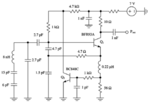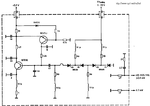Archimedes
Junior Member level 3
I need to build a low power, low phase noise 40-60 MHz VCO for an IF stage of RF receiever. The VCO is powered from 3.3V and must drive an SPDT switch IC (KISS mixer), so the output has to be fairly symmetrical. Right now I'm using a simple Clapp oscillator followed by a Schmitt trigger, it does the job but I want to make an oscillator with better phase noise performance and at the same time beginner-friendly. I've found a very interesting phase noise reduction method that uses 1/f noise feedback. Looks very promising but I can't find any information about its design. And I'm also not sure if it's applicable at frequencies that low:


I also saw some cascode and push-push topologies but still no clear design tutorials for those.


I also saw some cascode and push-push topologies but still no clear design tutorials for those.
Last edited: